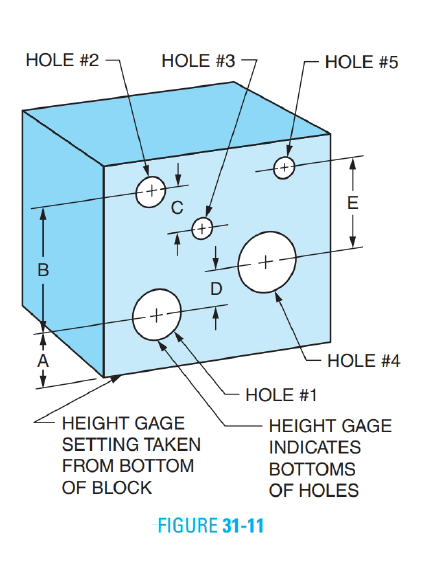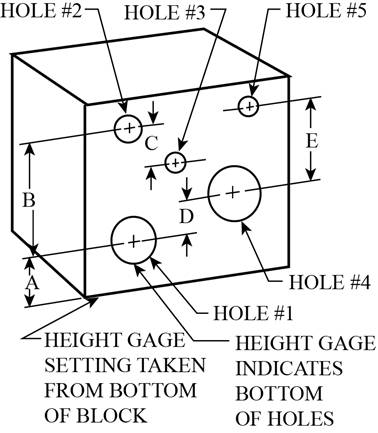
The hole locations of the block in Figure 31-11 are checked by placing the block on a surface plate and indicating the bottom of each hole using a height gage with an indicator attachment. Determine the height gage settings from the bottom of the part to the bottom of the holes. Assume that the actual hole diameters and locations are the same as the given dimensions. The setting for Hole Number 1 is given.


(1)
The main scale setting.
The vernier scale setting.
Answer to Problem 26A
The main scale setting is
The vernier scale setting is
Explanation of Solution
Given information:
The diameter of the hole
The figure below shows the hole locations from surface plate.

Figure-(1)
Write the expression for the height gauge settings.
Here, the distance between the center of the holes is
Write the expression for the relationship between vernier scale setting and main scale setting.
Here, the height gauge setting is
Calculation:
Substitute
The
Hence, the main scale setting is
As the lower value is required for the measurement, taking
Substitute
Hence, the vernier scale setting is
Conclusion:
The main scale setting is
The vernier scale setting is
(2)
The main scale setting.
The vernier scale setting.
Answer to Problem 26A
The main scale setting is
The vernier scale setting is
Explanation of Solution
Given information:
The diameter of the hole
Write the expression for the height gauge settings.
Here, the distance between the centers of hole
Calculation:
Substitute
The
Hence, the main scale setting is
As the lower value is required for the measurement, taking
Substitute
Hence, the vernier scale setting is
Conclusion:
The main scale setting is
The vernier scale setting is
(3)
The main scale setting.
The vernier scale setting.
Answer to Problem 26A
The main scale setting is
The vernier scale setting is
Explanation of Solution
Given information:
The diameter of the hole
Write the expression for the height gauge settings.
Here, the distance between the centers of hole
Calculation:
Substitute
The
Hence, the main scale setting is
As the lower value is required for the measurement, taking
Substitute
Hence, the vernier scale setting is
Conclusion:
The main scale setting is
The vernier scale setting is
(4)
The main scale setting.
The vernier scale setting.
Answer to Problem 26A
The main scale setting is
The vernier scale setting is
Explanation of Solution
Given information:
The diameter of the hole
Write the expression for the height gauge settings.
Here, the distance between hole
Calculation:
Substitute
The
Hence, the main scale setting is
As the lower value is required for the measurement, taking
Substitute
Hence, the vernier scale setting is
Conclusion:
The main scale setting is
The vernier scale setting is
(5)
The main scale setting.
The vernier scale setting.
Answer to Problem 26A
The main scale setting is
The vernier scale setting is
Explanation of Solution
Given information:
The diameter of the hole
Write the expression for the height gauge settings.
Here, the distance between hole
Calculation:
Substitute
The
Hence, the main scale setting is
As the lower value is required for the measurement, taking
Substitute
Hence, the vernier scale setting is
Conclusion:
The main scale setting is
The vernier scale setting is
Want to see more full solutions like this?
Chapter 31 Solutions
Mathematics For Machine Technology
- Find all solutions of the polynomial congruence x²+4x+1 = 0 (mod 143). (The solutions of the congruence x² + 4x+1=0 (mod 11) are x = 3,4 (mod 11) and the solutions of the congruence x² +4x+1 = 0 (mod 13) are x = 2,7 (mod 13).)arrow_forwardDetermine whether each function is an injection and determine whether each is a surjection.The notation Z_(n) refers to the set {0,1,2,...,n-1}. For example, Z_(4)={0,1,2,3}. f: Z_(6) -> Z_(6) defined by f(x)=x^(2)+4(mod6). g: Z_(5) -> Z_(5) defined by g(x)=x^(2)-11(mod5). h: Z*Z -> Z defined by h(x,y)=x+2y. j: R-{3} -> R defined by j(x)=(4x)/(x-3).arrow_forwardDetermine whether each function is an injection and determine whether each is a surjection.arrow_forward
- Let A = {a, b, c, d}, B = {a,b,c}, and C = {s, t, u,v}. Draw an arrow diagram of a function for each of the following descriptions. If no such function exists, briefly explain why. (a) A function f : AC whose range is the set C. (b) A function g: BC whose range is the set C. (c) A function g: BC that is injective. (d) A function j : A → C that is not bijective.arrow_forwardLet f:R->R be defined by f(x)=x^(3)+5.(a) Determine if f is injective. why?(b) Determine if f is surjective. why?(c) Based upon (a) and (b), is f bijective? why?arrow_forwardLet f:R->R be defined by f(x)=x^(3)+5.(a) Determine if f is injective.(b) Determine if f is surjective. (c) Based upon (a) and (b), is f bijective?arrow_forward
- 1 S 0 sin(lnx) x² - 1 Inx dxarrow_forward2 6. Modelling. Suppose that we have two tanks (A and B) between which a mixture of brine flows. Tank A contains 200 liters of water in which 50 kilograms of salt has been dissolved and Tank B contains 100 liters of pure water. Water containing 1kg of salt per liter is pumped into Tank A at the rate of 5 liters per minute. Brine mixture is pumped into Tank A from Tank B at the rate of 3 liters per minute and brine mixture is pumped from Tank A into Tank B at the rate of 8 liters per minute. Brine is drained from Tank B at a rate of 5 liters per minute. (a) Draw and carefully label a picture of the situation, including both tanks and the flow of brine between them. JankA 1ks of Salt Slits Pump EL Brine mit tark A from tank 13 Tank 13 k 3L zooliters of Ico liters of water with pure water. Saky salt → 777 disslore inside Brine mix is pumped from tank A to B of 82 Brine drainen min by Gf salt (b) Assume all brine mixtures are well-stirred. If we let t be the time in minutes, let x(t) 1ks…arrow_forwardNo chatgpt plsarrow_forward
 Mathematics For Machine TechnologyAdvanced MathISBN:9781337798310Author:Peterson, John.Publisher:Cengage Learning,
Mathematics For Machine TechnologyAdvanced MathISBN:9781337798310Author:Peterson, John.Publisher:Cengage Learning, Holt Mcdougal Larson Pre-algebra: Student Edition...AlgebraISBN:9780547587776Author:HOLT MCDOUGALPublisher:HOLT MCDOUGAL
Holt Mcdougal Larson Pre-algebra: Student Edition...AlgebraISBN:9780547587776Author:HOLT MCDOUGALPublisher:HOLT MCDOUGAL Elementary Geometry for College StudentsGeometryISBN:9781285195698Author:Daniel C. Alexander, Geralyn M. KoeberleinPublisher:Cengage Learning
Elementary Geometry for College StudentsGeometryISBN:9781285195698Author:Daniel C. Alexander, Geralyn M. KoeberleinPublisher:Cengage Learning Elementary Geometry For College Students, 7eGeometryISBN:9781337614085Author:Alexander, Daniel C.; Koeberlein, Geralyn M.Publisher:Cengage,
Elementary Geometry For College Students, 7eGeometryISBN:9781337614085Author:Alexander, Daniel C.; Koeberlein, Geralyn M.Publisher:Cengage, Glencoe Algebra 1, Student Edition, 9780079039897...AlgebraISBN:9780079039897Author:CarterPublisher:McGraw Hill
Glencoe Algebra 1, Student Edition, 9780079039897...AlgebraISBN:9780079039897Author:CarterPublisher:McGraw Hill





